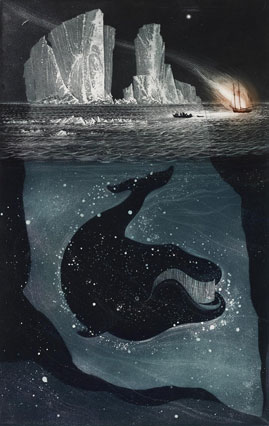
Last month, as his first major museum retrospective opened at the Art Gallery of Ontario in Toronto, I had the pleasure of chatting in person with David Blackwood. Blackwood is known, of course, for his dramatic prints of Newfoundland. Today, the National Post published my condensed Q&A with him. An excerpt:
Q: You're known for beautiful homages to Newfoundland--but you live in Ontario. Why?
A: Well, I was born in Newfoundland. I grew up there, went to school, graduated knowing that there was such a place as the Ontario College of Art. This was before the time of community colleges--no art school in Newfoundland.
So it seemed logical I would come to Toronto. When I was in my first year at college, it was impressed on students that it was important to have a subject, so that there'd be some purpose in what you're doing. Of course, even as a child I was very interested in drawing and painting. And with a subject: the local landscape. There's some of my teenage works in this exhibition--portraits of people in the community. This was disrupted at the college for a time because you were doing still life, things typical of an art school. But in my graduating year I was given a big one-man show. It was all mummers and sealers.
Q: Today, Newfoundland's tourism image is colourful and bright. Your images are just as stunning, but they're very dark. Why?
A: To begin with: Northeast coast of Newfoundland. Very pleasant in the summer--beautiful, sublime. In the winter . [makes fearful expression]. November, December, January, February, March, April, May, June: winter. Really severe. Then you have a pleasant period, July and August. But you can't count on it. You might wait until September, October where you have incredible sun every day. But never ever--summer or winter--without wind. We had one book in the house, the Family Bible, illustrated in black and white by Gustave Doré. Very dramatic images of very dramatic stories. So there was an influence there. It was only when my father passed away and I inherited this bible that I really became aware of it. I'd grown up looking at these images: Christ walking on the sea of Galilee, the fall of Babylon and Jericho, the ark on top of Mount Ararat.
Q: Your work often conjures biblical themes, especially your famous Fire Down on the Labrador. What inspired it?
A: You know, initially I was thinking of the idea of schooners and the fear of fire. The only thing they were afraid of was fire. The wind, the ice, the tide -all seemed to be manageable. But you would never go to sleep at night until you'd made sure that there were no glowing embers in the stove. Consequently, there were only short periods in the galley where the cook was working you'd have short periods of comfort. The rest of the time it would be tremendously damp and cold. That image is open to all sorts of interpretation. I got a phone call from a student at the University of Texas. He was taking a class and the professor was using this image to convey some philosophy of humanity and makeup of the universe, which had to do with man, bird, beast, fish, water, fire, ice. Everything, according to this particular person, was in that one image.
Blackwood also had some great stories I couldn't manage to include, like there being a guy who would show up once a month in his hometown of Wesleyville with a black and white projector and the engine to run it. He would show everything from newsreels to Laurel and Hardy. He also says having a very dramatic Shakespeare teacher in school had a big impact on him.
On a more political/procedural curatorial front, Blackwood says he believes this show wouldn't have happened without the longtime interest and support of AGO print curator Katharine Lochnan. Even when Lochnan was a student she had an interest in Blackwood's work, and pointed out the possible Doré connection to him. He also told me that since he lives in Ontario, Newfoundland institutions didn't seem, from his perspective, all that interested in collecting his work. Though this show will travel to the Rooms in St. John's this summer, and I'm sure be well loved there, it's worth noting that Blackwood gifted hundreds of his prints to the AGO in 1999--not to any other institution.
(Image of David Blackwood's Fire Down the Labrador from the AGO)
Monday, March 7, 2011
Black Ice: Q&A with David Blackwood out in Today's Post
Subscribe to:
Post Comments (Atom)

No comments:
Post a Comment